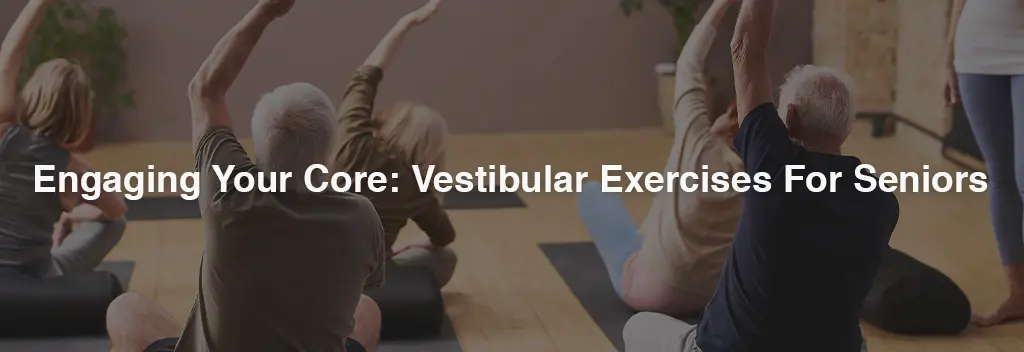As we age, maintaining balance and stability becomes increasingly crucial for living an active and independent life. For seniors, a compromised sense of balance can lead to falls, a common cause of injury among older adults. The vestibular system, which is located in the inner ear, plays a central role in regulating balance and spatial orientation. As this system naturally declines with age, it’s important for seniors to engage in specific exercises that help activate and strengthen this vital system.
Understanding the Vestibular System
The vestibular system is responsible for detecting changes in head position and movement, helping us maintain our sense of balance and coordination. This system consists of the semicircular canals and otolith organs in the inner ear, which work together to sense motion and gravity. However, as we age, the efficiency of this system tends to diminish, leading to a decrease in balance control. For seniors, this decline can result in dizziness, vertigo, and an increased risk of falls. Fortunately, targeted vestibular exercises can help preserve and even enhance balance, contributing to a higher quality of life.
Why Vestibular Exercises Are Essential for Seniors
Incorporating vestibular exercises into a senior fitness routine can provide a range of benefits that go beyond simply improving balance. These exercises help to:
- Prevent Falls: By improving proprioception (the awareness of body position) and spatial orientation, vestibular exercises can significantly lower the risk of falls, which are a leading cause of injury in older adults.
- Improve Posture: Seniors with a strong vestibular system can maintain better posture, which in turn can reduce back pain and improve overall comfort.
- Enhance Coordination: Regular vestibular training enhances the brain’s ability to process sensory information and coordinate movement. This can help seniors remain independent and perform everyday tasks more effectively.
- Boost Cognitive Function: Vestibular exercises not only benefit the body but also stimulate the brain, helping to prevent cognitive decline and improve mental sharpness.
- Increase Confidence: As seniors improve their balance and stability, they gain greater confidence in their ability to move safely and perform daily activities, which is essential for maintaining independence.
Effective Vestibular Exercises for Seniors
There are several exercises that target the vestibular system and can help seniors improve their balance, posture, and coordination. Here are some of the most effective vestibular exercises for seniors:
1. Head Turns and Tilts
Simple head movements can be an excellent way to engage the vestibular system. Side-to-side head turns and up-and-down head tilts help improve flexibility and balance without causing dizziness.
How to do it:
- Sit or stand with your back straight.
- Slowly turn your head to one side, hold for a second, and then return to center.
- Tilt your head up and down, holding each position for a moment.
- Perform 10 repetitions on each side.
This exercise can help increase the range of motion in the neck and improve spatial awareness.
2. Eye Tracking Exercises
These exercises challenge the vestibular system by focusing on visual tracking, which is closely linked to balance. They involve moving the eyes in different directions, stimulating the brain and improving spatial awareness.
How to do it:
- Sit comfortably with your eyes fixed on an object in front of you.
- Slowly move your eyes up and down, left and right, focusing on the object at all times.
- You can also try shifting your gaze between near and far objects to challenge the system further.
Perform 10 repetitions of each movement for both horizontal and vertical tracking.
3. Balance Exercises
Balance exercises are an effective way to build stability and reduce the risk of falls. These exercises include standing on one leg or in a tandem stance, both of which challenge the vestibular system.
How to do it:
- For the tandem stance, stand with one foot directly in front of the other, as if walking on a tightrope.
- Hold the position for 10-30 seconds, then switch legs.
- For the one-leg stand, lift one foot off the ground and balance on the other leg. Hold for 10-30 seconds, then repeat on the other leg.
Start by performing these exercises next to a stable surface for support and gradually increase the difficulty as your balance improves.
4. Dynamic Movement Exercises
Adding dynamic movements, such as seated marching or side-stepping, can enhance coordination and activate multiple muscle groups while also engaging the vestibular system.
How to do it:
- Seated marching: Sit in a chair with your feet flat on the floor. Lift one knee toward your chest, hold for a few seconds, and then lower it back down. Alternate legs in a marching rhythm.
- Side-stepping: Stand with your feet shoulder-width apart. Step to the side with one foot, then bring the other foot to meet it. Repeat for 1-3 minutes.
These exercises promote better coordination and stability by challenging both balance and movement.
5. Tai Chi
Tai Chi, with its slow and controlled movements, is a gentle exercise that is highly effective for improving balance and flexibility. It helps seniors develop body awareness and stability while reducing stress.
How to do it:
- Follow a simple Tai Chi routine that emphasizes slow, deliberate movements, focusing on balance and coordination.
- Many Tai Chi routines can be done while seated or standing, making them accessible for seniors with varying mobility levels.
Tai Chi is particularly beneficial for seniors because it combines balance training with mental relaxation.
6. Yoga for Vestibular Health
Certain yoga poses, such as the tree pose, can help seniors engage their vestibular system while improving balance and flexibility.
How to do it:
- Stand tall with your feet together and your weight evenly distributed on both legs.
- Lift one leg, placing the sole of your foot on the inner thigh or calf (avoid the knee).
- Hold the position for 30 seconds to a minute, focusing on balance and stability.
- Repeat on the other leg.
This pose encourages focus and stability while challenging the vestibular system.
Incorporating Vestibular Exercises into Daily Routine
For maximum benefits, seniors should aim to perform vestibular exercises regularly, ideally 3-4 times per week. These exercises can be incorporated into daily activities or done as a specific workout routine. Starting with gentle movements and gradually progressing to more complex exercises can help build strength and confidence over time.
Conclusion
As we age, the need to maintain balance, coordination, and stability becomes more critical than ever. Vestibular exercises offer a unique and effective way for seniors to improve their sense of balance and prevent falls, all while promoting better posture, cognitive health, and overall well-being. By engaging in these exercises regularly, seniors can gain greater confidence in their ability to perform daily activities and lead an independent, healthy lifestyle. Embrace the power of vestibular training today for a safer, more balanced tomorrow.



